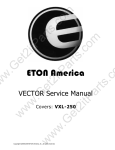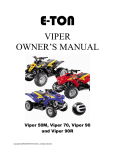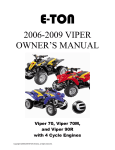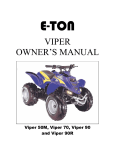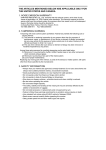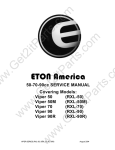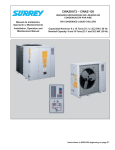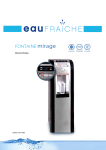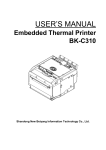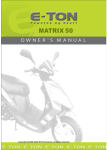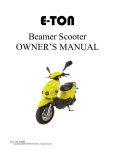Download E-TON Vector 250R Owner`s manual
Transcript
E-TON Vector 250R OWNER’S MANUAL Important Notices READ and UNDERSTAND this owner’s manual Both the operator and the adult supervisor should completely read and understand this owner’s manual before operating this vehicle. This owner’s manual will instruct you in the safe operation of the vehicle. NO Passengers This vehicle was designed for operation ONLY by the operator, (Driver). The load limit and seat configuration is designed for the operator ONLY. It is not safe to carry passengers on the vehicle. ADULT Supervision and Instruction are REQUIRED. This vehicle MUST NOT be operated by a youth without Adult supervision and instructions. Unattended operation without adult supervision could result in injuries. E-TON recommends that both the operator and the adult supervisor attend an ATV safety instruction course. ALWAYS Wear Protective Clothing While operating this vehicle, the driver must always wear protective clothing. Protective helmet with face shield, elbow and knee pads, long leg pants, gloves and hard soled boots should always be worn when operating this vehicle. OFF ROAD Use ONLY This vehicle is designed and manufactured for off-road use only. Operation on public streets, roads or highways is illegal and very dangerous. OBEY all State and local laws and regulations Each state and local governing agency has laws and regulations for ATV operations. It is the owner’s responsibility to know, understand and obey these laws and regulations. SPEED RESTRICTION Devices This vehicle is equipped with electronic speed limiting devices. Any attempt to change, over-ride or bypass these devices may cause dangerous operating conditions. Age Recommendations by model size ATV Model Size ETON Models Minimum Age Weight Capacity Under 70cc RXL-40Ee RXL-50M RXL-70 6 years and older 70 Lbs 70 - 90cc RXL-90 RXL-90R 12 years and older 250 Lbs over 90cc CXL-150 RXL-150R 16 years and older 250 Lbs Over 150cc VXL-250R 16 years and older 350Lbs Page 1 Table of Contents Important Notices.................................................................................................................................... 1 Safety Notes ............................................................................................................................................ 4 Additional safety tips: ............................................................................................................................. 7 Vehicle Identification Numbers.............................................................................................................. 8 Controls, Switches & Feature Locations ................................................................................................ 8 Engine Stop Switch................................................................................................................................. 9 Manual choke lever................................................................................................................................. 9 Throttle lever........................................................................................................................................... 9 Front and Rear Brakes .......................................................................................................................... 10 Parking Brake........................................................................................................................................ 10 Fuel Tank .............................................................................................................................................. 10 Fuel Valve............................................................................................................................................. 11 Inline Fuel Filter ................................................................................................................................... 11 Engine Oil ............................................................................................................................................. 12 Oil Level Warning indicator ................................................................................................................. 12 Changing the engine oil ........................................................................................................................ 13 Engine Cooling System......................................................................................................................... 13 Checking the level................................................................................................................................. 13 Engine Coolant Mixture........................................................................................................................ 14 Coolant system leaks............................................................................................................................. 14 Transmission ......................................................................................................................................... 14 Shifting gears ........................................................................................................................................ 14 Transmission Oil................................................................................................................................... 15 Tires and Wheel inspection................................................................................................................... 15 Tire Pressure ......................................................................................................................................... 16 Spark Plug............................................................................................................................................. 16 Spark Arrestor Screen ........................................................................................................................... 16 Air Filter................................................................................................................................................ 16 To clean the filter .................................................................................................................................. 17 Braking Systems ................................................................................................................................... 17 Front Brake System Inspection............................................................................................................. 17 Rear Brake System Inspection .............................................................................................................. 18 To Fill the Reservoir ............................................................................................................................. 19 Purging Brake Lines ............................................................................................................................. 19 Drive Chain........................................................................................................................................... 19 Drive Chain........................................................................................................................................... 20 Chain Slack Adjustment ....................................................................................................................... 20 Throttle Lever ....................................................................................................................................... 20 Adjusting the throttle cable................................................................................................................... 20 Electrical Battery .................................................................................................................................. 21 Digital Console ..................................................................................................................................... 22 ATV Break In procedures..................................................................................................................... 22 Pre-Operation Inspection procedure ..................................................................................................... 22 Starting Procedure................................................................................................................................. 22 Driving your ATV................................................................................................................................. 23 Turning your ATV ................................................................................................................................ 23 Parking Your ATV................................................................................................................................ 23 Vector 250R Specifications .................................................................................................................. 24 Page 2 Table of Contents Maintenance Schedule .......................................................................................................................... 26 Owners Maintenance Records .............................................................................................................. 26 Warranty ............................................................................................................................................... 27 Warranty ............................................................................................................................................... 28 Owner’s Notes: ..................................................................................................................................... 30 Page 3 Safety Notes 1. Both the adult supervisor and youth operator must fully understand everything in this manual before operating this vehicle. 2. This vehicle was designed for the operator only. NO PASSENGERS should be allowed on this vehicle. 3. This vehicle is designed for operation on level, obstacle free off-road areas. 4. Riding this vehicle on public roads or highways is illegal. If it becomes necessary to cross a public road or highway, the vehicle should be pushed across using extreme caution. 5. This vehicle MUST NOT be operated without adult supervision and instruction. 6. DO NOT operate this vehicle while under the influence of drugs, alcohol or other medication that impairs judgment or coordination. Doing so can result in serious injury or even death. 7. Maintain a safe distance between your vehicle and other vehicles with whom you are riding. 8. READ the owner’s manual carefully before riding. 9. ALWAYS wear a helmet, face shield, elbow & knee pads, hard-soled boots, gloves, and protective clothing while operating this vehicle. Page 4 10. NEVER ride this vehicle unless it has been properly maintained and adjusted. Always perform a pre-ride inspection of your vehicle. Look for wires, bolts and other fasteners that may have come loose on previous rides. Inspect the drive chain, throttle and brakes for proper adjustment and operation. Check the engine oil level in the oil tank. Check fuel level and inspect for fuel leaks. (Remember, you can ride further in 1 hour than you can walk back in 1 day!) 11. WARM UP your body with some exercises before riding. This helps to make you alert and prevent cramping and other discomfort. 12. LEARN TO RIDE this vehicle properly and safely. Have an experienced rider teach you the safe operation of your vehicle. E-TON recommends you take an ATV riding course before you first ride your vehicle. Page 5 13. NEVER REFUEL this vehicle when hot. Ask your adult supervisor to refuel your vehicle. Gasoline is extremely flammable and will ignite if spilled on a hot engine or muffler. Never smoke or expose the fuel to an open flame or spark while refueling your vehicle. Always refuel your vehicle in a safe place free of any ignition source. 14. NEVER run the vehicle in an enclosed area. The exhaust gases from the engine contain CARBON MONOXIDE which can be fatal if breathed in high concentrations for an extended time. 15. HOT! The engine and exhaust system on your vehicle become very hot during normal operation. Touching these hot surfaces can cause severe burns. Always assume that your unit’s engine and exhaust system are HOT unless you know that they are not. Page 6 Additional safety tips: • • • • • • • • • • • • • • • • • • • • • • • • • • • Participate in an approved ATV safety education training program Always provide responsible adult supervision for ATV operators younger than 18 years of age Don't let youngsters ride full-sized ATV's Follow all safety recommendations of the ATV manufacturer Operate ATVs only during daylight Wear a helmet with face protection at all times Operate only four-wheeled ATVs Provide a drug and alcohol free environment Always use the buddy system Avoid riding in areas where contact with automobiles might be possible Drive ATVs on surfaces as recommended by the manufacturer Travel at speeds conducive to conditions and operator abilities Check on the conditions of the trails you will be traveling Know and understand local and state laws governing the use of ATVs Permit only one operator per ATV Insist on a "perfect fit" between the ATV and the physical, mental, and emotional maturity of the operator Use antenna flags and wear bright clothing to increase conspicuity. Use maps and compass if you are riding in an unfamiliar area. Make a mental note of landmarks; you may need them if you are stranded. If you are lost at night, do not move around. You will waste valuable fuel that you can use to ride safety in the daylight. Carry a first-aid pack with you. Carry some snacks and a water supply with you. Carry equipment to handle medical and mechanical emergencies. Your vehicle field repair kit should include the following items; o the manufacturer's tool kit o wire, tape, elastic cords, o possibly locking pliers o and a tow rope. Pre-Ride Inspection - Inspecting the condition of your ATV before each ride is very important to minimize the chance of injury and maximize the enjoyment of your ride. It also helps ensures long term performance of your ATV. Follow the owner’s manual guide to inspection and maintenance of your ATV. A well maintained ATV will give you years of enjoyment. Watch out for thin ice which may be camouflaged by snow. Remember, you can ride further in one hour than you can walk in an entire day. Age Recommendations by model size ATV Model Size ETON Models Minimum Age Weight Capacity Under 70cc RXL-40Ee RXL-50M RXL-70 6 years and older 70 Lbs 70 - 90cc RXL-90 RXL-90R 12 years and older 250 Lbs over 90cc CXL-150 RXL-150R 16 years and older 250 Lbs Over 150cc VXL-250R 16 years and older 350Lbs Page 7 Vehicle Identification Numbers Your VIN RFZ______________ Eng. No._______________ Vehicle Identification Number (VIN) is located at the front of the unit under the front fender on a plate mounted between the main frame rails. Engine serial number is located on the left-hand side of the engine on the crankcase housing. Controls, Switches & Feature Locations Locations of controls and features 1. 2. 3. 4. 5. 6. Main Switch Fuel Tank Cap Parking Brake Lever Throttle Lever Front Brake Lever Speedometer / Odometer Fuel Gauge Headlight indicator 7. Engine Stop switch 8. Starter Button 9. Headlight switch 10. Horn Button 11. Manual Choke Lever 12. 12v DC Accessory outlet 13. Transmission Selector indicators 14. Gear Shift Lever 15. Cooling Radiator 16. Engine Oil Dipstick 17. Rear Brake Petal Page 8 Control Features Engine Stop Switch Throttle lever The stop switch is a red colored rocker switch located on the left-hand handle bar. To start and run the engine, this switch must be placed in the on, “Ω”, position. The throttle lever is located on the right-hand handle bar below the grip. To operate the throttle lever, place your right thumb on the lever and press forward to increase your speed. To decrease your speed, reduce your pressure on the lever and the spring tension will The vehicle is also equipped with a safety brake switch which will prevent the engine from starting until the parking brake is engaged. To stop your engine, place the switch to the stop, “ ”, position. In the stop, “ ”, position the ignition system is grounded preventing the spark plug from firing. This switch can also be used as a safety or emergency stop switch. automatically reduce your speed. Manual choke lever The travel of the throttle lever is controlled by the throttle stop bolt. All Vector is equipped with a manually operated carburetor choke system. This choke is operated by the lever at the bottom of the left hand control switch. When first starting the engine,(cold start), place the lever in the full left position, (Choke closed or on). As the engine warms return the lever to the full right position. (Choke open or off). As your operator gains more experience, you can increase the throttle travel to allow for additional speed to be obtained. To increase the throttle’s travel, thus increasing the maximum speed, turn the throttle stop bolt counter clockwise. To decrease the throttle’s travel, thus decreasing the maximum speed, turn the throttle stop bolt clockwise. Page 9 The throttle cable should be adjusted so there is 2mm, (1/8”) free travel at the lever before the throttle starts to open. Front and Rear Brakes This vehicle is equipped with dual front hydraulic Disc brakes and a rear hydraulic disc brake Fuel Tank The front brakes are controlled by the long brake lever on the right-handle bar. The rear brake is controlled by foot peddle located in the right foot well of the unit. The rear brake is the primary stopping brake on your vehicle. Using the rear brake to stop your vehicle will prevent steering control loss. Use your front and rear brakes in combination to control your speed while descending a grade. Use caution not to apply too much pressure to your front brakes so that the wheels lock up, stop turning, and causing a loss of steering control. If the front wheels lock up, and stop turning, lightly reduce the pressure on the front brake lever until they unlock and start to turn. Parking Brake The front brake, shown in the picture below, is located on the right hand side of the handle bar. The parking brake is engaged by moving the lever to the right and disengaged when by moving the leer to the left. The parking brake should be engaged when ever the unit is not in operation and when starting the unit. The fuel tank fill cap is located on top of the unit just ahead of the seat. The cap contains a vent to prevent a vacuum from forming in the tank as fuel is used. The vent tube must be attached to the cap and inserted in the vent tube holder hole while operating the unit. The fuel cap vent and vent tube must be clean and clear of obstructions for the unit to operate normally. You can check the vent and vent tube by blowing air through the tube. If you can not blow through the vent tube and cap you must clean the vent and tube or replace them. Every time you refuel your unit, check the rubber seal inside the cap for cuts, tears and dirt. Clean or replace the seal if it becomes worn or torn. The seal must be in good condition to insure a proper seal of the cap to the tank to prevent fuel spills. DO NOT allow dirt or other debris to enter the tank when refueling. Replace the cap if damaged or if it will not seal to the tank. Page 10 Tighten the cap snugly, being careful not to over tighten. Over tightening the cap can cause damage to the cap or seal. The fuel tank capacity is 12 liters, 3.17 gal, including a reserve of 2.5 liters, 0.66 gal. Use unleaded automobile gasoline with an octane level of 89 or higher. NEVER REFUEL YOUR ATV when the engine is HOT. Wait 30 minutes after turning off the unit before refueling. Spilling fuel on a HOT engine could cause a fire. Wipe up any fuel spills before re-starting. Fuel Valve The unit is equipped with a three way fuel valve located on the left side of the unit just below the seat. ALWAYS CHECK YOUR Fuel level before you start riding your ATV. Remember: You can drive further in one hour on your ATV than you can walk in one day. The “PRI” position of the valve allows fuel to flow freely from the tank bypassing the vacuum valve. The “PRI” setting is primarily use when draining the fuel from the tank for long storage periods or during vehicle maintenance. It can also be used in an emergency if the vacuum valve fails to operate correctly allowing the unit to be taken to a place where the fuel valve can be serviced. DO NOT operate the vehicle with the valve in the “PRI” position for long periods of time. Inline Fuel Filter Your ATV is equipped with an inline fuel filter to prevent dirt and debris from entering the carburetor and engine. The valve has three settings; “PRI”, “ON” and “RES”. With the valve in the “ON” or “RES” position fuel flow is controlled by a vacuum vale in the petcock. Fuel will begin flowing to the carburetor as soon as the engine is turned over. “ON” is the normal operation position of the fuel valve. When you have to switch to the “RES” position you must refuel the unit as soon as possible to prevent running out of fuel. Check the filter for dirt or damage before each ride and at each refueling. Replace the filter if dirty or damaged. The filter should be replaced every 600 hours of operation and at the start of each season. To replace the filter, first turn the fuel valve to the “ON” or “RES” position. Then carefully unscrew the filter bowl from the bottom of the fuel vale by Page 11 turning the bowl counter clockwise. Remove the old filter by pulling down on the filter to disengage the pressure fitting from the mount. Install the new filter by pressing up until the filter snaps in place over the mount and re install the filter bowl by turning clockwise until it is hand tight. Turn the fuel valve to the “PRI’ position to fill the filter bowl with fuel and check for leaks. Return the fuel valve to the normal “ON” operating position. Inspect the fuel lines running from the tank to the fuel valve and the line running from the valve to the carburetor. Replace any line that shows signs of wear or cracking and any line that is leaking fuel. DO NOT start or operate the engine if the fuel filter or lines are leaking. Leaking fuel can cause a fire. Engine Oil The engine oil dip stick is located on the right side of the unit and can be accessed through the cutout in the footrest side guard. To check the oil level remove the dipstick by turning counter clockwise until it is completely free of the engine case. The level of oil can be gauged by the level indicated on the dipstick. The level should be maintained between the low and high indicators on the dipstick. If the oil level is low add enough additional oil, SAE 10W-30, to return the level to a safe position. DO NOT over fill the engine oil level as this can cause engine damage or failure. Always check your engine oil level with the engine off and in a cool state. Checking the oil level while the engine is hot can give a false reading. Removing the Oil level dipstick with the engine running may allow hot engine oil to splash from the crankcase causing burns. The engines oil capacity is 1.2 Liters / 1.2 Quarts. E-TON recommends an automotive oil grade of SAE 10W-30 be used. Oil Level Warning indicator The unit is also equipped with an oil level indicator located in the lower left hand corner digital console display. The lamp will light when the oil level in the engine is low. When the lamp is lit you MUST STOP the engine and refill the engine oil reserve to a safe level. DO NOT allow the engine to operate with an empty oil tank. Doing so will result in extensive damage to your engine. This damage is not covered under the warranty. Checking the engine oil level Your ATV uses an automotive type engine oil to lubricate and cool the engine. It is important to maintain a proper oil level to prevent damage and/or failure of the engine. Check the engine oil level before each riding session and at each refueling operation. Page 12 Changing the engine oil The engine oil requires changing every 1800Mi / 3000KM and at the start of each riding season to protect the engine. The following steps should be followed when changing the engine oil. 1. Place a oil catch pan directly below the engine crankcase. 2. Remove the crankcase drain plug located on the bottom of the crankcase on the underside of the unit. 3. Remove the engine oil dipstick located on the right hand side of the crankcase directly below the transmission shift lever. 4. Allow the oil to drain completely (1530min). 5. Reinstall the crankcase drain plug and torque to 7-10lb-ft. 6. Fill the crankcase with SAE10W-30 automotive grade engine oil through the dipstick hole. 1.2 liters / 1.2 quarts. 7. Reinstall the engine oil dipstick and finger tighten 8. Dispose of used oil at a proper recycling station as required by law. Engine Cooling System The Vector engine is a liquid jacketed cooled engine. Cooling is accomplished by circulating liquid coolant from the engine coolant jacket through a radiator located at the front of the unit. If is very important to keep the radiator fins clean and free of debris and mud to prevent engine overheating which can cause engine damage or failure. You need to routinely clean the radiator by using a pressurized spray of water. Maintaining the coolant level is also a very important process to ensure proper engine cooling. The coolant level should be checked before each riding session and the coolant replaced at the beginning of each riding season. Proper maintenance of the cooling system will prevent the engine from overheating and freezing. Coolant should be change every 2 years. Checking the level With the unit parked on level ground, remove the front grill cover and check that the coolant level in the reserve tank is between the upper and lower limit indicator lines. If the coolant level is near or below the lower limit add coolant to raise the coolant level to the upper limit indicator line. Coolant should be a mixture of distilled water and anti-freeze. CAUTION: Add coolant through the reserve tank. The coolant system runs under pressure. Page 13 Removing the radiator cap while the coolant system is hot can cause over boiling and serious burns or other injuries season for signs of deterioration such as cracking of checking of the hose surface. Replace cooling system hoses at least every 3 years. Transmission Engine Coolant Mixture The engine coolant should be a mixture of distilled water and anti-freeze solution with a specification rating of H68. The following chart will help you determine the correct water to anti-freeze ratio. Operating Anti-freeze solution temperature percentage 32° to -8° F 20% -9° to -15°F 30% -16° to -24°F 40% -36° to -45°F 50% Your unit was shipped with a 50% solution. Coolant system leaks If your coolant system is consistently low on coolant there in most likely a leak in the system. Start the unit and allow it to run until it has reached it operating temperature. Check the coolant system radiator and hoses for leaks and repair or replace as needed. Inspect cooling system hose at the beginning of each Shifting gears The Vector 250 is equipped with a fully automatic C.V.T. transmission and has a forward and reverse gearing system. The transmission shift lever is located of your unit just below and ahead to the seat. The shifter has a three position notched locator plate indicating transmission gear selections of “F”, “N” and “R” “F” = Forward “N” = Neutral “R” = Reverse The position of the transmission gears is also indicated on the digital console directly below the digital readout display. It contains the same three indicators of “F”, “N”, and “R”. To start your engine, both the shift selector lever and the shift indicator lamp on the console must be in the “N”, neutral, position. To shift from one gear to another, bring the unit to a complete stop and while applying either the rear or front brake slowly move the shift selector lever to the desired gear pausing slightly in the neutral position to allow for the transmission gears to synchronize. One the shift is completed Page 14 lightly apply pressure to the throttle until you feel the unit shift and the indicator light confirms the shift has been completed. If the brakes are not fully applied while shifting the transmission the engine will stop running. Transmission Oil every 3000Km/ 1800 Mi or at the beginning of each riding season which ever come first. The following steps should be followed when changing the transmission oil. 1. Place a oil catch pan directly below the transmission case. 2. Remove the transmission drain plug located on the bottom of the transmission case on the underside of the unit. 3. Remove the transmission filer plug located on the upper right hand side of the transmission case above the transmission shifting linkage rod. 4. Allow the oil to drain completely (1530min). 5. Reinstall the transmission drain plug and torque to 7-10lb-ft. 6. Fill the transmission case with SAE85W-140 automotive grade gear oil through the filler hole. 650cc / 22oz. 7. Reinstall the transmission filler hole plug and torque to 2-3Lb-ft. 8. Dispose of used oil at a proper recycling station as required by law Tires and Wheel inspection The Vector 250 requires SAE85W-140 gear oil to lubricate and cool the transmission and drive gears. Transmission oil level should be checked before each riding session and change It is important to inspect your tires and wheels for damage and wear before each riding session. Inspect each tire for cuts, tears and punctures. Inspect the wheel rim for dents and separation of the wheel from the tire bead. Page 15 Replace any tire or wheel found to be damaged. Operating your ATV with damaged tires or wheels is dangerous. Damaged tires or wheels can result in a sudden loss of tire pressure and control which could result in injuries. Check your tire pressure before each riding session and at each refueling operation. Always check the pressure when the tires are cool. Use the tire pressure gauge that came with your ATV to check the tire pressure. Tire Pressure Recommended tire pressures are: Min 3.2psi / 0.23kg/cm Front Max 4.0psi / 0.28kg/cm Min 3.2psi / 0.23kg/cm Rear Max 4.0psi / 0.28kg/cm Wheel Nut torque 24-30 N/m (18-22 lb/ft) Spark Plug Set the spark plug gap on the new plug to 0.023” Install the new plug screwing it in finger tight and then use the plug wrench to screw the plug in another ½ turn. Inspect the spark plug wire for cuts, nicks or other damage. Replace as needed. Spark Arrestor Screen Required maintenance and cleanout: 1. After every 1800Mi / 6000Km of operation the muffler should be cleaned by removing the clean out bolt by using a 12mm wrench. 2. After every 1800Mi / 6000Km of operation the Spark Arrester has to be cleaned by loosening the retaining nut using a 10mm socket. Using pliers turn the sleeve of the Spark Arrester counterclockwise and pull out. Clean the screen with an exhaust cleaning solution and replace, securing it by tightening the retaining nut. 3. After every 2 years of operation the Spark Arrester has to be replaced by loosening the retaining nut using a 10mm socket or wrench. Using pliers turn the sleeve of the Spark Arrester counterclockwise and pull out. Replace a new Spark Arrester and secure it by tightening the retaining nut. Air Filter Air Filter Maintenance Replace spark plug at the beginning of each season with a replacement plug NGK – CR8E. Disconnect spark plug wire. Clean dirt from around spark plug base with brush or air. Remove spark plug with spark plug wrench. Page 16 5. Soak the element in clean engine oil until completely saturated. 6. Squeeze out the excess oil until the element does not drip any oil. 7. Allow the element to dry then reinstall the element and cover. Braking Systems Your ATV unit is equipped with dual front hydraulic disc brakes and a single rear hydraulic disc brake. The front brakes are applied by applying pressure to the brake lever located on the right-handle bar, while the rear brake is applied by applying pressure to the foot peddle located in the right hand foot rest area. To maintain the highest performance from your engine and to reduce excessive wear that could cause engine failure the engine requires a continuous flow of clean air. Air is taken into the engine through an air filter to clean the air prior to mixing it with fuel and oil in the carburetor. During normal operation the filter accumulates dirt from the air and will need to be cleaned to maintain the proper air flow. The filter should be cleaned every 30 days, more often if you ride in a dusty or dirty environment and the element should be replaced every year. Proper maintenance of the brake system is a necessary part of safe operation of your unit. The brake systems should be inspected and tested before each riding session. Front Brake System Inspection Visually inspect the brake lines for any signs of wear. Inspect the lines for cracks and checking of surface that could lead to line rupture. Replace all questionable lines before operating your unit. Check the fluid level in the master brake cylinder to insure that the fluid is at least covering ¾ of the site glass. Add brake fluid as needed. The air filter box is located on the left side of the engine under the front fender. It is a black box about 6” square and is attached to the crankcase with two bolts and the carburetor by a tube. To clean the filter 1. Remove the air filter box cover. 2. Remove the filter element from the air box. 3. Wash the element in a non-flammable solvent such as Air-Filter cleaner from your local auto parts dealer. 4. Dry the element completely before continuing. Page 17 Brake fluid Dot-3 SAE-J1703 grade. Inspect brake line joints and wheel cylinders for leaks and repair as needed. Rear Brake System Inspection Apply the brakes by squeezing the brake lever. The level should stop with the brakes fully apply and at least ½” / 13mm of clearance between the brake lever and the handle bar grip. It there is less than ½” / 13mm clearance or the lever is not firm the brake pads may require changing. Or the line may need bleeding. Insect the brake pads for wear and be sure they are clean and free of dirt and mud. Brake pad service limit is 0.06” / 1.5mm thick. Replace pads that are at or below the service limit. Visually inspect the brake hose for any signs of wear or leaks. Inspect the brake rotor for cracks and warp. Replace defective rotor as required. The brakes are equipped with a wear indicator to alert you when your brake shoes need replacing. Apply light pressure to the brake lever and slowly push the unit forward. If you hear a high pitched metallic scraping sound, you need to replace your brake shoes. The minimum shoe lining thickness is 1.5mm. DO NOT RIDE A UNIT WITH WORN BRAKE PADS or DAMAGED ROTOR. Check the fluid level in the fluid reservoir by checking the site glass for the level. The fluid Reservoir should be at least ¾ full when the unit is setting on a level surface. Test the brakes by applying pressure to the brake pedal and trying to push the unit forward. If the wheel rotates while the brakes are applied, check your fluid level and brake pads. If the brake pedal feels spongy or does not stop when squeezed, you may have air in the lines. All air must be purged from the brake lines for the disc brake to operate properly. Page 18 Purging Brake Lines For the hydraulic brake system to operate safely, the brake system must be purged of air in the lines and reservoir. To After riding your unit, be sure to clean any build up of mud, sand and dirt from the brake rotor skid plate. This will protect the rotor disc from rust and corrosion. To Fill the Reservoir Remove the reservoir cover by removing the two cover bolts. Fill the reservoir to 1/8” from top with Dot-3 SAEJ1703 grade brake fluid. Caution: DO NOT allow dirt to fall into the reservoir. Refold the cover gasket as shown in picture and replace cover and bolts bleed the air will require two people to perform the following procedure. 1. Place a drain pan under the brake caliper to catch the fluid. 2. Open the bleeder valve ½ turn counter clockwise. 3. Press the brake pedal to expel air from the system. 4. While holding the brake pedal, close the bleeder valve. 5. Repeat steps 2 through 4 until the brake fluid coming from the bleeder valve is a solid stream without any air, then close the valve and replace rubber protection cap. 6. Test the brake system by pressing the pedal, the pedal should feel firm and stop without fading. Page 19 Drive Chain The drive chain will stretch with use and will require periodic adjustments. To check the chain tension, remove the chain guard and measure the slack. The amount of slack in the chain should not exceed 10-20mm or ¼” - ½”. Inspect the drive and axle sprockets for worn, damaged or broken teeth. Replace as needed. Inspect the chain links for damaged, worn or loose rivets. Repair or replace as needed. hours of operation, or more frequently if needed, with a high quality chain lubricant. Throttle Lever The throttle lever is located beside the righthandlebar grip and is operated by using the righthand thumb. The lever is spring loaded and will return to the idle position when you remove your thumb from the lever. To accelerate the unit, simply press the lever forward to open the throttle slide in the carburetor. To slow the unit, reduce the pressure on the lever or remove your thumb and the throttle will return to the idle position automatically. Chain Slack Adjustment Loosen the axle position lock bolt slightly and turn the chain adjuster nut to take up the excess slack in the chain. Once the chain has been adjusted to the proper tension retighten the axle position locking bolt. The chain should be kept well lubricated to prevent excess wear and premature failure. We recommend that you lubricate the chain every 15 Adjusting the throttle cable Page 20 The cable should be adjusted to allow for ⅛” free travel before the throttle engages the carburetor throttle slide. To adjust the cable’s free travel, loosen the locking nut of the cable adjuster, and turn the adjuster wheel until there is ⅛” free travel When reinstalling the battery, be sure to connect the red cable to the positive (+) terminal and the black cable to the negative (-) terminal. The battery should be replaced every three years or when it no longer holds a charge. in the lever. Tighten the locking nut to secure the adjusting ring. The speed of the unit can be adjusted by adjusting the throttle stop screw to limit throttle travel. Loosen the throttle stop screw locking nut and turn the throttle stop screw clockwise to reduce the throttle travel thus reducing the maximum speed of the unit. Turning the stop screw counter clockwise will increase the throttle travel thus increasing the maximum speed of the unit. Tighten the stop screw locking nut when the desired throttle travel has been established. Do not expose the battery, for extended periods of time, to freezing temperatures. If the battery has been frozen it will need to be replaced. There is an inline fuse on the positive lead of the battery to protect the wiring system from over loads. If your starter motor will not turn over and the battery is fully charged, check the inline fuse on the unit. If your starter motor will not turn over and the battery is fully charged check the inline fuses NOTE: Your unit includes an electronic speed control that is set to limit the maximum speed of the unit to the standards set by the CPSC for the age of the rider the unit was designed for. Electrical Battery The unit’s battery is located under the seat and supplies electrical power to the unit. The battery is a 12 volt jell acid type that contains no liquid electrolyte. The battery should be removed from the vehicle when stored for extended periods and charged before being replaced in the unit. Use a trickle charger set at 12 volts to recharge the battery to full charge before replacing it in the unit. Page 21 Digital Console The Vector 250 is equipped with a digital console which displays information about the operating conditions of your ATV. 1. For the first two weeks of operation do not run your ATV at full throttle for extended periods of time. 2. Your first tank of fuel should be a premixture of fuel and oil at a 50:1 ratio. This will insure that the oil pump system has been primed and bled of air that may have occurred in shipping. 3. Do not operate the unit at more than 85% of maximum speed. 4. Do not over rev the engine. 5. Use light braking pressure to allow the brake pads to seat to the rotor and drums. Pre-Operation Inspection procedure The following procedure must be performed before each operating session. Information displayed are; 1. Speedometer 2. Odometer 3. Fuel level 4. Transmission gear position 5. Hi-Beam Indicator 6. Oil Level WARNING! 7. Engine Temperature WARNING! When you first turn the ignition key on all the indicator should illuminate as a test of the LED If an LED fails to light when the ignition key is first turned on you should replace the console assembly. The console has two buttons. The left hand button will reset the oil level warning lamp and the right hand button will zero the trip odometer. ATV Break In procedures Your ATV requires a break in period just as with all other internal combustion engines. This period allows the engine parts to seat and wear properly without undue strain which can cause premature failure. Checking your ATV takes only a few minutes and may save you from serious injuries and costly repairs. 1. Check engine oil level. 2. Check engine fuel level. 3. Check brake operations and brake fluid Level. 4. Check tire condition and pressure. 5. Check drive chain condition and slack. 6. Check throttle operation and free play adjustment. 7. Check engine stop switch for proper operation. 8. Check steering system. Look for free and smooth operation. Check all fastening hardware. 9. Check all nuts, bolts and other fasteners for loose conditions. 10. Inspect unit for any broken or damaged parts. 11. Check all indicator lights and switches for proper operation. 12. Insure you are wearing proper clothing and protective gear. Helmet, Gloves Pads etc. Starting Procedure The following procedure must be followed each time you start your unit. Page 22 Park the unit on a level surface and lock the parking brake. Place the transmission gear selector switch in the “N”, Neutral, position. Insert the key into the ignition switch and turn to the “ON” position. Turn the engine stop switch to the “ON” position. Set the manual choke lever to the full left position (Choke close or on) Apply front or rear brakes. Apply slight pressure to the throttle lever. Press the starter button on the left-handle bar. Your unit should start within 10 seconds of pushing the starter button. If the unit fails to start check the following. 1. Engine stop switch is “ON”. 2. Parking Brake Locked “ON”. 3. Transmission selector switch in the “N” position. 4. Set the manual choke lever to the full left position (Choke close or on) throttle to allow the rear wheels to turn properly. When making a turn, the wheels on the outside of the turn must travel a wider radius and thus a greater distance than the inside wheels of the turn. Since the rear axle does not permit a different rate of rotation, it is not enough to merely steer your ATV into the turn. To turn properly, steer in the direction of the turn and lean your body to the inside of the turn while supporting your weight on the outer footrest. Use the throttle to maintain power throughout the turn. If you do not use this turning technique the unit will have a tendency to continue in a straight line. If this occurs, release the throttle lever to allow the unit to stop. Avoid braking or accelerating until you have regained directional control. Parking Your ATV Driving your ATV Your ATV should only be driven in an area that is designated for this use. Insure that the area is free of obstacles and other dangers that could cause a loss of control. Check with your local authorities for any regulations regarding the use of your ATV. Always keep your feet on the footrests and your hands on the handle bar grips while operating your ATV. Doing so will give you the best control of the unit. 1. Always park your ATV on a level surface. 2. Turn the ignition key to the “OFF’” position to stop the engine. 3. Set the engine stop switch to “OFF” position. 4. Engage the parking brake locking button. 5. Turn the fuel valve to the “OFF” position. 6. Remove the ignition key to prevent unauthorized use or theft of your ATV. Start your ATV by following the starting procedure above and allow the engine a few minutes to warm up before releasing the parking brake. Start the unit by slowly increasing the throttle until the unit begins moving. Turning your ATV Learning to turn your ATV requires you to learn to shift your weight and control the Page 23 Vector 250R Specifications Engine Type Displacement Bore / Stroke Compression Ratio / Pressure Torque / BHP Four cycle , Single Cylinder, Liquid cooled 249cc φ71mm * 63mm 10.6 : 1 22.3Nm @ 5500rpm / 16.4bhp Meet or exceeds EPA clean air requirements/CA Green Sticker Electrical starter EPA Approved Starting Transmission Type Automatic (C.V.T. V-Belt) Manual Shift Fwr/Rev Chassis Overall Length Overall Width Overall High Wheel Base Seat Height Ground Clearance Dry Weight 1780mm / 70.1" 1030mm / 40.6" 1140mm / 44.9" 1190mm / 46.9" 890mm / 35.0" 150mm / 5.9" 200kg / 441lbs Suspension Front Rear Dual A-arm Adjustable Shocks @ 2.95" travel Swing Arm Adjustable Shock @ 4.72" travel Brakes Front Rear Hydraulic Disc (2) Hydraulic Disc Tires Front Rear Front Tire Pressure Rear Min Max Min Max 21/7-10 22/11-9 3.2psi / 0.23kg/cm2 4.0psi / 0.28kg/cm2 3.2psi / 0.23kg/cm2 4.0psi / 0.28kg/cm2 Wheels Bolt Pattern Carburetor Make/Size Main Jet Pilot Jet Air Mixture Adjustment Idle Speed Kei-Hin with Manual choke 1.1mm 0.35mm Back out 1 - 2½turns Idle 1600 - 1800rpm Page 24 Sprockets Front Rear Chain 520x15t 520x38t #520*90 O-Ring Battery Jell Acid (Maintenance Free) 12V-9AH - GTX12-BS Fluids Type Volume Type Volume Type Volume Fuel Engine Oil Transmission Unleaded Gasoline 89 octane 12liters / 3.17gal SAE 10-30W 1.4liters / 1.4gt (1.2liters / 1.2qt for change) SAE 85/140 weight gear Oil 750cc / 25.4oz (650cc / 22oz for change) Spark Plug NGK NGK-CR8E Electrode Gap 0.6-0.7mm / 0.023" Carrying Capacity Front Rear Towing Trailer Wgh Capacity Tongue Wgh Maximum Rider Weight Minimum Rider Age Rack Capacity Available Colors N/A 16kg / 301lb (Optional) 330kg / 727lb (Optional) 50kg / 110lbs 150kg / 330lbs 16 years Red Blue *subject to availability Page 25 Maintenance Vector 250R Schedule Pre-Ride Safety Inspection 300Km 200Mi 1 Month 1000Km 600Mi 3 Months Fuel Lines I Throttle Operation I I Air Filter I C 3000Km 1800Mi 6 Months 6000Km 3500Mi 12000Km 7500Mi 1 Year 2 Years I Notes: R R Fuel Filter R Spark Plug I I Drive Chain I,L Brake Pads I I Brake System I I Brake Fliud I Bolts, Nuts, & Fastners I I Wheels & Tires I I Steering System I Suspension System I R Lubricate every month R I I I I I C.V.T. Drive Belt I Transmission Oil R R Change every 6 month Engine Oil R R Change every 6 month Battery Engine Oil Sump Screen I I,C C C Valve Clearance I Coolant I Coolant Fan I I I Carburetor Idle Speed I I I Choke I Spark Arrestor I I I R C Change every 2 years R I = Inspect, Clean, Adjust, Lubricate or Replace as needed C= Clean L = Lubricate R = Replace Owners Maintenance Records Maintenance Preformed Date Page 26 Preformed By Vector 250R Wire diagram Page 27 Warranty ETON AMERICA, LLC. LIMITED VEHICLE WARRANTY ETON America warrants all new ETON vehicles sold by authorized Eton Dealers to be free from defects in materials and workmanship, subject to the following exclusions and limitations. New vehicles sold by an authorized dealer to original retail consumers are covered by this policy for a period of six (6) months from the date of delivery. There is no mileage limitation. Vehicles used in rental service or for certain commercial purposes are specifically excluded from this policy. (Check with your dealer for warranty application.) Items and conditions that are specifically excluded from this warranty program are; 1. Damage caused by accidents, misuse, negligence, improper vehicle operation. 2. Any modification or alteration to any standard specifications or equipment. 3. Any repairs made by an unauthorized dealer or service firm. 4. Use of non-ETON genuine parts for repairs or alteration to standard specifications. 5. Damage caused by failure to perform factory scheduled service maintenance. 6. Damage which occurs as a result of improper storage. 7. Damage caused by the use of improper fuel or lubricants, and/or failure to use proper oil/gas mixture on two stroke models. The following normal wear parts are specifically excluded from warranty coverage: 1. Rubber parts 2. Tires 3. Belts 4. Brake linings 5. Normal wear item 6. Brake parts 7. Cables 8. Filters 9. Spark plugs 10. Bulbs 11. Batteries 12. Sprockets 13. External springs 14. Seat and hand grips. Page 28 ETON AMERICA, LLC. LIMITED VEHICLE WARRANTY Scheduled maintenance service is the responsibility of the owner during and after the warranty period. In the event of a failure or required repair, the owner should take vehicle to an authorized dealer for repair without undue delay and within a maximum of thirty, (30), days of the occurrence of the problem. All eligible warranty repairs must be made at any authorized dealer’s normal place of business. Any transportation costs, or other expenses which may occur in order to obtain warranty service, are the responsibility of the owner. All eligible repairs covered under this warranty will be paid to the servicing dealer only, by ETON America, and no additional payments shall be made for authorized warranty repairs. Dealer and/or ETON America are not responsible for loss of use, other damage or inconvenience due to warranty repairs. It is the customer/buyer’s responsibility to review with the selling dealer the pre-delivery service schedule to assure machine is properly serviced prior to delivery acceptance. It is recommended that the buyer take a test ride to familiarize themselves with the machine and to make certain the unit is in proper operating condition. The dealer is responsible for checking and performing all items on the “set-up and pre-delivery checklist” prior to delivery to the customer. This warranty is valid at any authorized ETON Dealer in the United States only. In the event you experience any problem obtaining prompt service, contact ETON America, customer service department for assistance. Always consult first with your selling dealer and or service personnel for assistance with any service work or repairs. In the event you have a problem obtaining service send your name, address, and vehicle identification number to Eton America for assistance. The above stated policy is the only policy offered and backed by ETON America, and no other organization or individual is authorized to make or offer any different arrangements. Some states prohibit certain limitations or conditions or do not allow exclusions or limitations. You may be eligible for additional consideration, so check with your local dealer or appropriate state agency for assistance. Rights vary from state to state, and you may have other rights not offered in this warranty. ETON America warrants all new vehicles comply with applicable US regulations. Page 29 Owner’s Notes: Page 30 Page 31

































